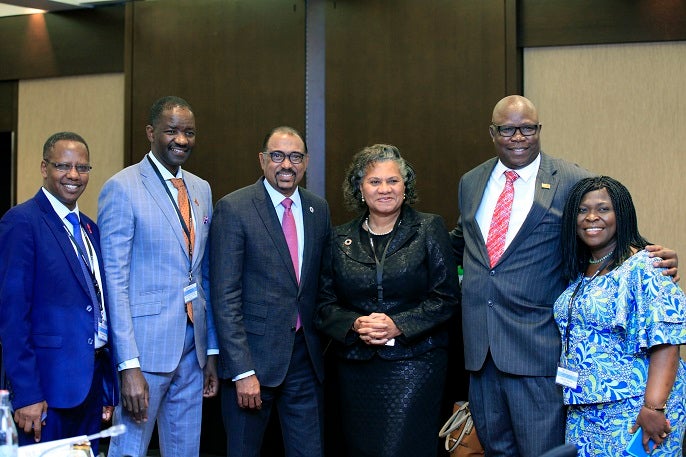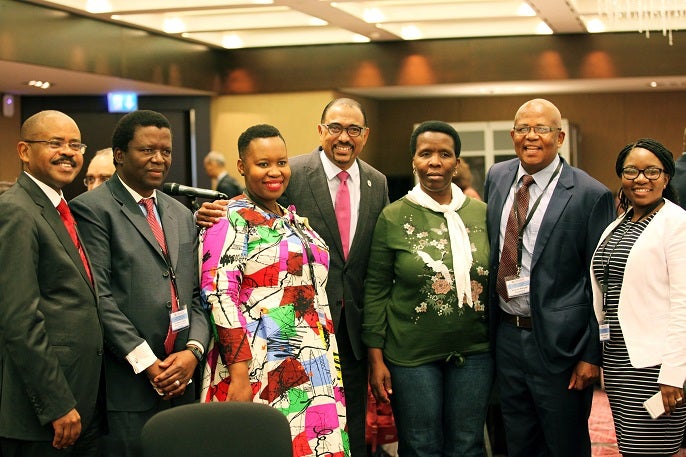
HIV Prevention Global Co-Leaders,UNFPA Executive Director Dr. Natalia Kanem and UNAIDS Executive Director Mr. Michele Sedibe
Background
Globally, there is much that has been done in the fight against HIV and AIDS epidemic. HIV treatment programs have significantly increased and have proven a preventive effect where the progression of the virus is suppressed for those living with the virus. Achieving the 90–90–90 targets for HIV treatment is therefore critical. All available evidence, however, show that treatment alone will not be sufficient to control the epidemic—primary prevention also needs to be scaled up vigorously. What has been of serious concern is the feminisation of HIV infection where it has been found to be persistently high among adolescent girls and young women. Key populations are also suffering the same fate. This remains a major challenge due to the fact that HIV prevention is a potential winning strategy in the HIV response because it costs less yet it continues to lag behind and is underfunded.
The pioneers of the Global Coalition on HIV Prevention (the UNAIDS and late UNFPA Executive Director and World Bank) realised the low decline of the HIV incidence in the East and Southern African regions (ESA) despite the massive roll out of HIV treatment initiatives such as the [1]3 by 5 mission over the years. They then steered the HIV prevention and revitalisation efforts in ESA as early as 2015 during an AU Summit. To this end a Global HIV Prevention Coalition was formed collaboratively co-led by UNFPA and UNAIDS to strengthen and sustain political commitment for primary prevention through setting a common agenda among key policy-makers, funders and programme implementers.
It is against this background that the coalition was launched on the 10th October 2017 in Geneva, Switzerland. Prior to its launch national consultations with key stakeholders were held at country level to ensure an inclusive process. A national state preparedness was determined through taking stock of where each country is on the implementation of key HIV prevention interventions.

ESARO Regional Director, Dr. Julitta Onabanjo with the UNAIDS Executive Director Mr. Michele Sedibe and other country delegates
Launch of the Global Coalition and Roadmap
The global coalition meeting was officially opened by the UNAIDS and UNFPA Executive Directors (Dr Natalia Kanem and Mr. Michele Sedibe). In his statement Mr. Sedibe noted that reducing the HIV incidence requires new energy and momentum by all actors and thus appreciated the UNAIDS Co-sponsors and Civil Society Organisations for supporting the coalition as its success requires all actors to join to end AIDS. He further emphasised that promoting equity is key in ensuring we reach the HIV prevention targets. He further stated “through equity, dignity, social justice and reducing inequalities amongst key groups that have been left behind we will ensure we are able to reach great strides in reducing the number of adolescent girls and young women, aged 15-24 years old, newly infected with HIV globally each year to below 100 000 by 2020”.
Dr. Kanem emphasized that prevention is better than cure. In her words she said” sticks in a bundle do not break” meaning that working together on HIV prevention will deliver more impact hence the establishment of the coalition on HIV prevention as a strategic move for concerted efforts for all key partners. She further stated that boldness of prevention is a key result of Sexual and Reproductive Health (SRH) services. She noted that young people continue to lack access to information and services on SRH thus compromising their well-being resulting in their vulnerability to teenage pregnancy and contracting, STI’s and HIV. Dr. Kanem further highlighted that condom work in UNFPA is bearing good results and is ensuring that sexually active people are protected from STIs, HIV and pregnancy.

UNAIDS Executive Director Mr. Michele Sedibe with the Swazi delegation
Role of UNFPA in the Global Coalition
In her statement during the official closing of the global meeting, Dr Julitta Onabanjo- the UNFPA Regional Director for East and Southern Africa appreciated the strong support by countries and key partners to get the coalition work to where it is and noted that this is a legacy for the late UNFPA Executive Director. She appreciated stakeholders for fully engaging in the process by setting national targets for HIV prevention as an indication of urgency to measure progress and need for accountability. She committed UNFPA’s support to the work of the HIV Prevention Coalition as outlined below:
- National leadership for HIV prevention through facilitating prevention inclusion into the national strategic plans and development plans. This will be anchored into the responsibility of Heads of States.
- Regionalisation – support regionalisation of HIV prevention through cross boarder and cross community programmes
- Sexual and Reproductive Health and Rights- promote rights for all, especially rights of the youth and those left behind. UNFPA as a UN organisation on SRH will continue to implement integrated programmes on SRH and HIV. It addresses issues of young people such as Comprehensive Sexuality Education (Life Skills Education), Youth friendly services, Youth leadership and empowerment.
- Condom programming- all pillars of condom programming shall be addressed including supplies for key populations such as lubricants
- UNFPA’s leading role the organisation will stay ahead of the epidemic through research/innovation on programming e.g. use of Information Technology to disseminate information to the youth. UNFPA will focus on young people especially “the 10- year old girl who is to be protected from vulnerability as she grows and gets to be 24 years by 2030”.
As part of the closing of the Conference, the Regional Director requested UNFPA delegates to continue the Global Coalition momentum and scale up advocacy for HIV prevention to fully claim our space. They were further requested to support the domestication of the roadmap including target setting and monitoring of progress through the score card. Resource mobilisation and bilateral discussions with in country partners and donors was recommended as one key initiative for fund raising and leveraging resources to support UNFPA work. She further requested delegates to watch out and support country teams to push for the UNFPA SRH-HIV integration agenda. Innovative financing for HIV prevention was also recommended such as financing through the private sector. The Director also emphasized to the delegates to share their experiences through communicating more on UNFPA HIV prevention work at country level.
[1] The "3 by 5" initiative, launched by UNAIDS and WHO in 2003, was a global target to provide three million people living with HIV/AIDS in low- and middle-income countries with life-prolonging antiretroviral treatment (ART) by the end of 2005.

